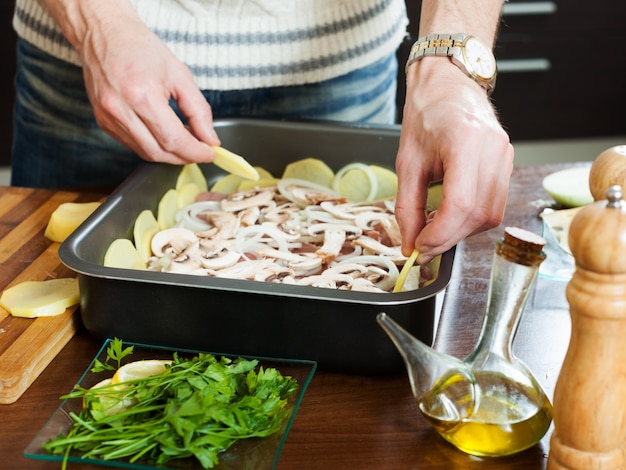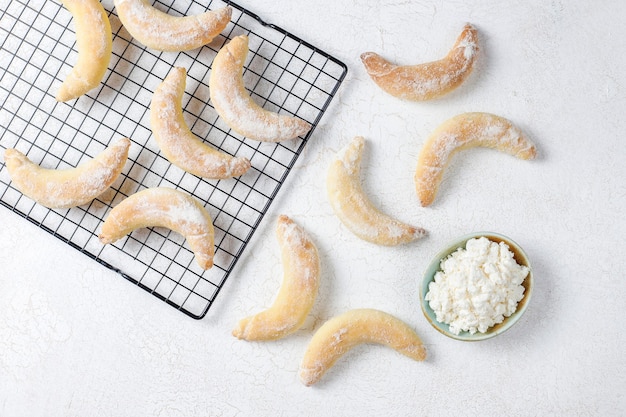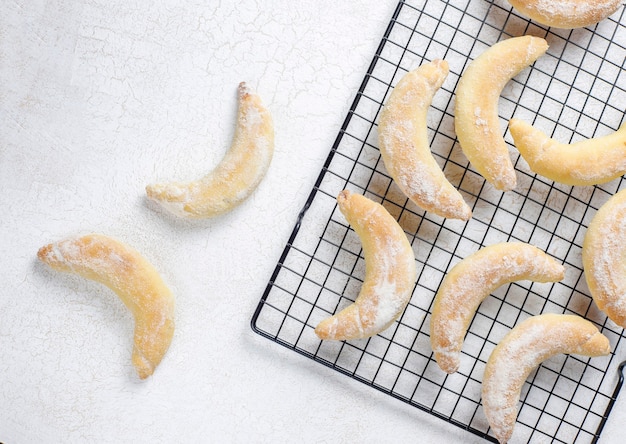Let's talk about squid. This often-overlooked cephalopod gets a bad rap, labelled as chewy and rubbery. But trust me, when cooked right, squid can be a culinary delight! It's got a subtle, almost sweet flavour and a wonderful firm texture that makes it incredibly versatile. Think grilling, frying, stuffing, or even adding it to a pasta sauce – the possibilities are endless!
I've been a squid fan for years and have learned a thing or two about making it absolutely delicious. There's a bit of a knack to it, sure, but with the right techniques, anyone can cook up a squid feast.
So, if you're ready to give squid a go, grab your apron, gather your ingredients, and let's dive into the world of squid cooking!
(Part 1) Picking the Perfect Squid

First things first, you need the right squid. Here's what I look for when I'm choosing my squid at the market:
Look for Freshness
Freshness is key. The squid should have a pearly, almost translucent white colour. Any signs of yellowing or browning means it's not as fresh. Imagine it like a pearly white shell, that's what you want! The skin should also be shiny and smooth, like a well-polished pearl. You don't want any damage, tears, or slime on the skin - those are signs of mishandling.
Feel for Firmness
Give the squid a gentle squeeze. It should feel firm and springy to the touch, like a bouncy ball. If it feels soft and mushy, it's past its prime and won't cook up as well. Always check the odour too. Fresh squid should have a clean, slightly salty scent, reminding you of the sea. A fishy or unpleasant smell is a definite no-no.
(Part 2) Preparing the Squid

Once you've got your fresh squid, it's time to prep it. This is a straightforward process that can be done in a few minutes. Let me show you how:
Cleaning the Squid
If you're buying pre-cleaned squid, you can skip this step and move on to the next one! However, if you're buying whole squid, it's time to get your hands a bit messy. Here's how to clean it:
- Remove the head: Grab the head of the squid and pull it away from the body. It should come off easily. You can discard the head.
- Pull out the innards: Inside the head, you'll find the innards, including the gills and the ink sac. Gently pull these out and discard them. You can save the ink sac for later if you're making squid ink pasta, but it's perfectly fine to discard it if you're not.
- Remove the beak: The beak is a hard, pointed structure found in the mouth. You can either pull it out with your fingers or use a small knife. It's best to discard it.
- Peel the skin: You can remove the skin by gently peeling it away with your fingers. It should come off easily, leaving the squid white and pearly.
- Rinse thoroughly: Rinse the squid under cold running water to remove any remaining innards or dirt.
Tenderising Squid
Squid can sometimes be a bit tough, so it's always a good idea to tenderize it before you cook it. This will make the squid more tender and prevent it from getting rubbery. Here are a few techniques:
- Score the squid: Use a sharp knife to make diagonal cuts across the squid, being careful not to cut all the way through. These cuts help the squid cook more evenly and break down the muscle fibers.
- Tenderize with a mallet: Use a meat mallet to gently pound the squid, which helps to break down the muscle fibers and make it more tender. This is particularly useful if you're planning to grill or fry your squid.
- Marinate the squid: Marinating the squid in a mixture of lemon juice, olive oil, and herbs for at least 30 minutes can also help to tenderize it. The acid in the lemon juice helps to break down the tough muscle fibers, making the squid more tender.
(Part 3) Simple Squid Recipes:

Now we're ready for the fun part – cooking! Here are some of my favourite squid recipes that are easy to make, and sure to impress your friends and family.
Grilled Squid with Lemon and Herbs
This is a classic and simple way to cook squid. The flavours are bright and fresh, and the grilling gives the squid a lovely char. It's perfect for a summer barbecue or a light and healthy meal.
Ingredients:
- 1 pound of squid, cleaned and tenderized
- 2 tablespoons of olive oil
- 1 lemon, cut into wedges
- 2 cloves of garlic, minced
- 1 tablespoon of chopped fresh parsley
- Salt and black pepper to taste
Instructions:
- Preheat your grill to medium-high heat. You want a nice hot grill to sear the squid quickly.
- In a bowl, combine the olive oil, lemon juice, garlic, parsley, salt, and pepper. This creates a fragrant marinade that will infuse the squid with flavour.
- Add the squid to the bowl and toss to coat. Make sure all the pieces are well coated in the marinade.
- Place the squid on the grill and cook for 2-3 minutes per side, or until cooked through and slightly charred. You'll know it's done when the squid is opaque and firm to the touch.
- Serve immediately with lemon wedges for a tangy squeeze.
Squid Stir-Fry with Vegetables
This is a quick and easy weeknight dinner that's packed with flavour and nutrients. It's a great way to use up leftover vegetables and can be adapted to your liking. I love using bell peppers, onions, and mushrooms, but feel free to experiment with your favourites!
Ingredients:
- 1 pound of squid, cleaned and tenderized
- 1 tablespoon of olive oil
- 1 onion, thinly sliced
- 1 red bell pepper, thinly sliced
- 1 green bell pepper, thinly sliced
- 1 cup of sliced mushrooms
- 2 cloves of garlic, minced
- 1/2 cup of soy sauce
- 1 tablespoon of honey
- 1 teaspoon of sesame oil
- Salt and black pepper to taste
Instructions:
- Heat the olive oil in a large skillet or wok over medium-high heat. You want the oil to be hot enough to sear the squid and vegetables quickly.
- Add the onion and bell peppers to the skillet and cook for 5 minutes, or until softened. The vegetables should be slightly translucent and tender.
- Add the mushrooms and garlic to the skillet and cook for 2 minutes more. The garlic should become fragrant and slightly browned.
- Add the squid to the skillet and cook for 2-3 minutes, or until cooked through and slightly browned. The squid should be opaque and firm to the touch.
- In a small bowl, whisk together the soy sauce, honey, sesame oil, salt, and pepper. This creates a delicious and savoury sauce.
- Pour the sauce over the squid and vegetables in the skillet and cook for 1 minute more. This allows the sauce to thicken and coat the ingredients.
- Serve immediately over rice or noodles. It's a perfect combination of textures and flavours.
Squid Ink Pasta
This is a bit more adventurous, but if you're up for a challenge, it's an incredible dish! The squid ink gives the pasta a unique black colour and a slightly salty, briny flavour. It's a real showstopper and is sure to impress your dinner guests.
Ingredients:
- 1 pound of squid, cleaned and tenderized
- 1/2 cup of squid ink
- 1 pound of pasta (linguine or spaghetti works well)
- 1/4 cup of olive oil
- 2 cloves of garlic, minced
- 1/2 cup of dry white wine
- 1/4 cup of chopped fresh parsley
- Salt and black pepper to taste
Instructions:
- Bring a large pot of salted water to a boil and cook the pasta according to package directions. You want the pasta to be cooked al dente, meaning it should have a slight bite.
- While the pasta is cooking, heat the olive oil in a large skillet over medium heat. This will help to create a fragrant base for the sauce.
- Add the garlic and cook for 1 minute, or until fragrant. Don't let the garlic brown, as this can make it bitter.
- Add the squid to the skillet and cook for 2-3 minutes, or until cooked through. The squid should be opaque and firm to the touch.
- Add the squid ink to the skillet and cook for 1 minute more. The ink will start to thicken and create a rich, black sauce.
- Pour in the white wine and bring to a simmer. The wine will deglaze the pan, adding a depth of flavour to the sauce.
- Cook for 2-3 minutes, or until the sauce has thickened slightly. The sauce should have a creamy consistency.
- Drain the pasta and add it to the skillet with the sauce. Toss to coat the pasta in the sauce.
- Serve immediately with a sprinkle of parsley for a finishing touch. The parsley adds a touch of freshness to the dish.
(Part 4) Understanding Squid Texture
Squid has a unique texture that can be tricky to master. It's known for being slightly chewy, but that can be a good thing if you know how to cook it. Here's a breakdown of the different textures you might encounter:
Tender and Chewy
This is the ideal texture for squid. It should be tender enough to bite into easily, but still have a bit of a chew. It's like a firm bite that gives way to a satisfyingly tender texture. You can achieve this texture by tenderizing the squid properly and cooking it over medium-high heat.
Tough and Rubbery
Squid can become tough and rubbery if it's overcooked. This usually happens if you cook it over too low a heat for too long. The squid essentially toughens up like an old rubber band! To prevent this, make sure you cook the squid over medium-high heat and don't overcook it.
Soft and Mushy
If the squid is too soft and mushy, it's likely that it wasn't fresh to start with. Fresh squid should have a firm texture that holds its shape. It's best to use fresh squid for the best texture.
(Part 5) Squid cooking times: A Guide
The cooking time for squid will depend on the method you're using. Here's a general guide:
Squid Cooking Times:
| Cooking Method | Approximate Cooking Time |
|---|---|
| Grilling | 2-3 minutes per side |
| Stir-frying | 2-3 minutes |
| Sautéing | 3-4 minutes |
| Baking | 10-15 minutes |
Remember, the squid should be cooked through, which means it should be opaque and firm to the touch. If you're not sure if it's cooked through, you can cut into it to check. If it's still translucent, it needs to be cooked for a bit longer.
(Part 6) Squid Storage: Keep it Fresh!
Fresh squid is best, but sometimes you need to keep it for a little while. Here's how to store squid correctly:
Storing Fresh Squid
If you're using fresh squid, store it in the refrigerator for up to 2 days. Wrap it tightly in plastic wrap or place it in an airtight container. This will help to prevent the squid from drying out and losing its flavour.
Storing Frozen Squid
If you need to store squid for longer, you can freeze it. Wrap it tightly in plastic wrap and then place it in a freezer-safe bag. This will help to prevent freezer burn. Frozen squid can be stored for up to 3 months.
Thawing Frozen Squid
To thaw frozen squid, place it in the refrigerator overnight. You can also thaw it in a bowl of cold water for a couple of hours. Do not thaw squid at room temperature, as this can promote bacteria growth.
(Part 7) Squid: A Versatile Ingredient
Squid is a truly versatile ingredient that can be used in a variety of dishes. Here are some ideas to spark your culinary imagination:
Squid in Appetizers:
- Squid Rings with Garlic and Chilli: Fry the squid rings in a little olive oil until crisp, then toss them in a mixture of garlic, chilli, and fresh herbs. It's a quick and flavourful appetizer that's perfect for parties or casual gatherings.
- Squid Salad: Combine cooked squid with chopped vegetables, olives, and a light vinaigrette. It's a refreshing and light appetizer that's perfect for summer.
Squid in Main Courses:
- Squid Paella: A traditional Spanish dish with rice, seafood, and vegetables. It's a hearty and flavorful dish that's perfect for a crowd.
- Squid Stew: A hearty stew with squid, potatoes, tomatoes, and spices. It's a comforting and satisfying dish that's perfect for a cold night.
- Squid Curry: A fragrant curry with coconut milk, spices, and vegetables. It's a flavourful and aromatic dish that's sure to please everyone at the table.
Squid in Sides:
- Squid Salad: A simple salad with chopped squid, vegetables, and a light vinaigrette. It's a healthy and refreshing side dish that's perfect for summer.
- Squid Fritters: Deep-fried squid fritters with a dipping sauce. They're a delicious and crispy side dish that's perfect for parties or casual gatherings.
(Part 8) FAQs: Squid Cooking Questions
Here are some frequently asked questions about cooking squid, along with my answers:
1. How do you tell if squid is cooked through?
Cooked squid should be opaque and firm to the touch. It should no longer be translucent, and it should have a slightly springy texture. If it's still translucent or feels soft, it needs to be cooked for a bit longer. You can also cut into the squid to check if it's cooked through. The inside should be white and opaque, not translucent.
2. What happens if you overcook squid?
Overcooked squid will become tough and rubbery. It's like chewing on a rubber band! It's important to cook squid over medium-high heat and not overcook it.
3. What can I substitute for squid ink?
If you don't have squid ink, you can use a black food colouring or even a few drops of black sesame seed oil. Just be careful not to use too much, as it can make the sauce too dark.
4. What's the best way to clean squid?
The best way to clean squid is to remove the head, innards, beak, and skin. You can use a sharp knife to remove the beak and skin, and then rinse the squid thoroughly under cold water.
5. What are some good squid recipes for beginners?
Some good squid recipes for beginners include Grilled Squid with Lemon and Herbs, Squid Stir-Fry with Vegetables, and Fried Squid Rings with Garlic and Chilli. These recipes are all relatively easy to make and require minimal ingredients.
I hope this article has inspired you to give squid a try! It's a delicious and versatile ingredient that's worth exploring. Happy cooking!
Everyone is watching

How to Cook Frozen Lobster Tails Perfectly: A Step-by-Step Guide
RecipesLobster. Just the word conjures up images of lavish meals, special occasions, and a taste of luxury. But let's...

Pork Fillet Cooking Time: How Long to Cook It Perfectly
RecipesPork fillet, or tenderloin as it's sometimes called, is a real favourite in our house. It's so versatile, and...

Pigs in a Blanket Cooking Time: How Long to Bake for Perfect Results
RecipesAh, pigs in a blanket. Just the name conjures up images of those delightful little parcels of crispy pastry en...

The Ultimate Guide to Cooking Delicious Frankfurters
RecipesLet's face it, we all love a good frankfurter. It's a classic, simple, and always satisfying. But let's be rea...

Wolf Meat Recipes: A Guide to Cooking Wild Game
RecipesLet's be honest, you don't see wolf meat at your local butcher shop every day. It's a bit of a wild card, but ...
